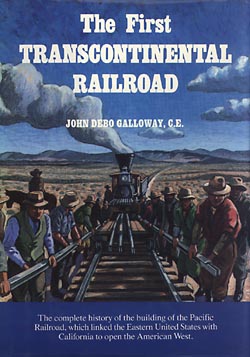
|
||
|
Issue 24 |
|
19 February 2002 |
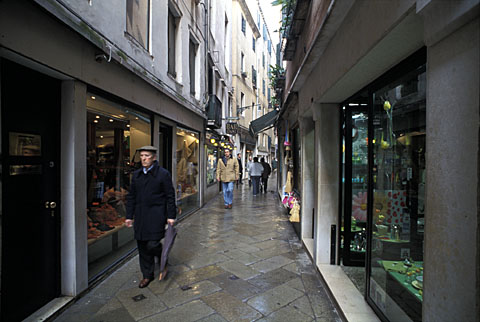 San Marco, just after the rain March 2001 News at Carfree.comCarfree Cities DistributionCarfree Cities continues to be available from Barnes and Noble, which usually offers a 20% discount and prompt shipment. If ordering from outside the USA, or to order from another source, please visit the How to Order page.Fes-Al-BaliJ.H. Crawford joined a workgroup studying Fes-Al-Bali, Morocco, this January. Fes-Al-Bali is the medina of Fes and is probably the largest intact medieval area in the world. It is also, on the basis of population, probably the largest contiguous carfree area in the world today. Read a report on Fes-Al-Bali.Papers at Carfree.comWe're pleased to announce that Carfree.com is now publishing papers that previously appeared in journals, starting with Mark Perry's excellent examination of how transport influenced the tragedy in Lebanon. We welcome submissions of other papers, either previously published or new. We do not presently have a peer-review procedure in place.Quotable
Woodrow Wilson, 1912
Oil Slick AwardTo Bush & Co. (again!), for scrapping efforts to improve vehicle fuel efficiency in favor of fuel cell technology, an approach that will do nothing to reduce US dependence on fossil fuels.
|
World News Notes & CommentBad Air and Birth DefectsPregnant women exposed to air pollution are more likely to deliver children with heart defects, according to a study in the American Journal of Epidemiology. Beate Ritz, the epidemiologist who headed the study, said, "There seems to be something in the air that can harm developing fetuses."The only two pollutants measured were CO and ozone, which are produced in large quantities by Los Angeles traffic jams. According to Ritz, "The greater a woman's exposure to one of these two pollutants in the critical second month of pregnancy, the greater the chance that her child would have one of these serious cardiac birth defects. More research needs to be done, but these results present the first compelling evidence that air pollution may play a role in causing some birth defects." Pregnant women living near busy freeways were three times as likely to have a child with certain heart defects as women breathing the cleanest air. Specific defects were found: conotruncal heart defects, pulmonary artery/valve defects and aortic artery/valve defects. No other birth defects were linked with the pollution. Researchers admit that there is only an association - causality has not been established, but researchers suspect that if it isn't the CO and ozone causing the problem, that some other constituent in tailpipe emissions is to blame. Particulates are under suspicion, as they are known to carry a cocktail of toxins, including quinones and polycyclic aromatic hydrocarbons (PAHs). "They become a great delivery device for toxic agents," Ritz said. Ritz noted that some of the affected neighborhoods were very wealthy, which tends to rule out other causes such as poverty and poor health care. Ethnicity and education level also did not correlate with pollution and birth defects. Some other factors, including smoking, occupational exposures, vitamin supplement use, diet and obesity were not controlled by the study design.
"Pollution linked with birth defects in U.S. study" The startling specificity of the birth defects strongly suggests to me that vehicle emissions are indeed the culprit here. Asthma and OzoneA decade-long study has shown that children who breathe heavily polluted air are much more likely to develop asthma. Scientists claim that the study is the strongest evidence yet that smog not only aggravates existing childhood asthma, now an epidemic among American youth, but may actually induce the life-threatening disease.Asthma is the leading serious chronic illness among youth and afflicts 9 million American children. It has been known for some time that smog can trigger attacks in asthmatics, but the new study shows that ozone can cause asthma in the first place. The California Air Resources Board sponsored the study, which was conducted by the University of Southern California and published in Lancet. Even though air in the USA has become steadily cleaner in recent years, in many cities, on many days, smog levels still exceed generally-accepted safe levels. The cleanup so far is inadequate to protect children's health. In the study, 3,535 Southern California children were followed over five years. In half of the communities air was comparatively clean, and the other half had some of the dirtiest air in the USA. The researchers focused on children who participated in active sports for at least five years, starting at age nine. Some 265 children were diagnosed with asthma during the study period, and those most likely to develop the disease were exercising in the most polluted cities. "This research suggests that contrary to conventional wisdom, ozone is involved in the causation of asthma," said Rob McConnell of the University of Southern California. The research controlled for other risk factors. "Somewhat to our surprise, in low-ozone communities, we found no increased risk of asthma in children who played team sports," said McConnell. The children who played the most active sports in the most polluted areas developed the most asthma. "The bottom line is this: Exercise is really healthy for children, for many reasons, and children should be encouraged to play team sports," he said. "But on days when air pollution levels are expected to be high, children should limit prolonged outdoor exertion." The researchers suggested that parents in areas with dirty air monitor pollution forecasts and take appropriate action, such as stopping exercise and play.
"Study: Pollution May Cause Asthma" "Appropriate action" might also include demanding that something be done about Bush & Co.'s friends in industry who are causing the problem in the first place. Oh, by the way - Bush & Co. is reviewing emission standards for factories and refineries, with an eye to relaxing requirements. Park It!A cold, dry winter in northern Italy has led to several smog emergencies during which drivers were required, not asked, to stop using their cars. Normal rainfall helps wash microscopic particles out of the air. Particle levels in Milan have at times risen to five times the permitted maximum.Similar traffic bans have also been implemented in the south this winter.
"Cars banned in smog-bound northern Italy " DOADeaths due to road collisions are still increasing in the developing world, although they have declined in the rich nations. According to the Mobility 2001 report from the Sustainable Mobility Project, between 80,000 and 90,000 people are killed each year in road collisions in Western Europe and North America. In some countries, road accidents are the leading cause of death in the 15- to 30-year-old age group.The situation is much worse in other parts of the world. |
| Place | Auto-Related Deaths/100,000 Population |
|---|---|
| Bangalore, India | 16.1 |
| Brazil | 18.3 |
| Johannesburg | 33.3 |
| G7 nations | 0.6~1.6 |
|
Poor countries suffer 80 times as many traffic fatalities per vehicle as rich nations. Pedestrians, cyclists, and poor people are disproportionately represented among road victims.
"Traffic fatalities increasing in poor countries" This is old news reported with new numbers. It's been bad, it's still bad, and it's getting worse. Same old story - rich people speeding in their cars are slaughtering poor folks walking or biking. Japan Betrays KyotoProbably acting under pressure from Bush & Co., Japan has abandoned the Kyoto Protocol it had only recently accepted. Japanese industry groups pressed the government to drop mandatory limits on greenhouse gas emissions that would have been adopted under the terms of the Kyoto agreement. It thus becomes improbable that Japan will meet its targets. The voluntary limits adopted by the Environment Ministry almost certainly mean that Japan will not attain the agreed 6% reduction. Japan's emissions of CO2 have risen by 17% since the 1990 benchmark, making the agreed reductions hard to achieve.Japan apparently still plans to ratify the treaty in June, during a regular session of Parliament. The protocol is a matter of some pride for Japan, which had brokered the deal during the 1997 Kyoto Conference. However, when Bush & Co. abrogated the agreement in March 2001, Japan doubted that the agreement would have any meaning in the face of America's determination to continue unrestricted global warming emissions. Japan announced its intention to ratify the agreement in November, several months after most of the world's nations announced their intention to proceed with the treaty even in the face of American intransigence.
"Japan casts aside Kyoto agreement" How is it that this significant event rated hardly more than a footnote in the world press? Why is Japan even maintaining the fiction of ratifying the treaty while announcing that they will not adopt measures to abide by it? Is this not strange? Cape Cod, a Tropical Paradise?A global warming scenario for the US Northeast: maple sugar trees stop producing sap, ocean beaches shrink and even disappear in places, cases of deadly heatstroke triple, and once in ten years a storm surge floods lower Manhattan. That is the grim forecast if global warming is not arrested, and it could come within the lifetime of today's children. In 70 years, New York will have as many 90-degree days a year as Miami does today.Boston may become as hot and humid as Atlanta. The bad news is that this is the good news - less optimistic projections are even worse than the 6 to 9 degree Fahrenheit rise in temperatures foreseen by George Hurtt at the University of New Hampshire in a report commissioned by the US Congress. "That's the greatest increase in temperature at any time since the last Ice Age." Important species of trees may disappear from New England in just a few decades, and while this might be accompanied by increased crop yields, the brilliant fall foliage might become a thing of the past. Contrarian Robert O. Mendelsohn of Yale said, "Even in the extreme scenarios, the northern United States benefits from global warming." Scientists estimate that the USA has a decade or two in which to adapt to accelerating global warming.
"Northeast Seen Getting Balmier Well, the ocean waters of New England always were too cold for swimming. And who needs maple syrup anyway? Bush & the Magic Fuel CellBush & Co. is turning the tables on clean-vehicle development. The Energy Department subsidized research into a high-efficiency automobile during the Clinton administration. Bush's henchman has now announced a change: high fuel economy is out, fuel-cell vehicles are in. Energy Secretary Spencer Abraham, in announcing the change at the Detroit Auto Show, said, "I am pleased to announce a new public private partnership [i.e., subsidy] between my department and the nation's automobile manufacturers to promote the development of hydrogen as a primary fuel for cars and trucks."Abraham seems to believe that hydrogen, which is actually a secondary fuel [as the Secretary of Energy might be expected to know], would reduce US reliance on OPEC oil. Abraham continued, "Under this new program, which we call Freedom CAR, the government and the private sector will fund research into advanced, efficient fuel cell technology which uses hydrogen to power automobiles without creating any pollution. The long term results of this cooperative effort will be cars and trucks that are more efficient, cheaper to operate, pollution free and competitive in the showroom." The Freedom CAR ("Cooperative Automotive Research") project supersedes Clinton's Partnership for a New Generation of Vehicles (PNGV) program, which culminated in the demonstration of hybrid vehicles from each of the Big Three that got nearly 80 MPG. Abraham said that Freedom CAR will focus on the research needed to develop technologies such as fuel cells and hydrogen from domestic renewable sources. It is expected to take at least 10 years to bring fuel-cell cars to market. By contrast, highly efficient hybrid cars have been in production for several years (although only Japanese manufacturers seem to have been able to get them to market). The NRDC's David Hawkins noted that during those 10 years, Americans will buy 150 million vehicles, He warned that the USA "can't afford another research program that just gives billions of dollars in subsidies to the automobile industry with no commitment from them to actually produce advanced vehicles for consumers to buy."
"Feds Dump Fuel Efficiency for Fuel Cells" I'm never surprised when politicians prostitute themselves, only that the price is always so low. Detroit will get billions in subsidies for a campaign investment probably measured in the thousands. This is accounting that even Arthur Andersen can get right. And of course they can keep building those profitable SUVs for another 10 years. DC Streetcars - Comeback Kid?The US capital was served by streetcars for nearly a century, before Congress killed them in 1962, ordering their replacement with stinking diesel buses. But on the 40th anniversary of the last streetcar run, officials are dusting off the streetcar. Three possible routes have been identified. The federal government has funded the District's idea with US$750,000 in research money."There's something reassuring about a streetcar line," said Peter C. Kohler, author of a book about the waning years of the District streetcar. "It's permanent. It's a commitment to downtown. It defines cities and neighborhoods." "When they were eliminated, they were seen as a nuisance. And today, they're seen as quaint and charming and good for urban transit," said Mahlon Anderson (53) of AAA(!). He remembers vividly when his grandmother took him to ride the last trolleys on 28 January 1962. "She told me, 'Mahlon, you mark my words: Washington will rue the day it eliminated trolley service.'". In 1975, only seven US cities still operated streetcar systems. Today, 19 cities operate streetcars, now rechristened "light rail," with 10 extensions or new systems under construction. A further 43 systems are on the drawing boards. Light rail vehicles normally draw power from overhead wires. In Washington, however, a congressional ban on overhead wires poses a special problem. The power source for the old streetcars was beneath track. Dan Tangherlini, the District's director of transportation, is hoping for a modern-day solution that will not significantly add to the cost.
"D.C. Transit May Go Retro Take that subsidy for fuel-cell cars and use it to develop fuel-cell trams, instead. Car-Crazed in BeijingThe ever-industrious Chinese are rooting under the mattress and finding enough cash to buy a car. In Beijing, car sales are soaring, despite an average weekly wage of only about US$120. If China reaches US levels of car ownership, it could have 600 to 800 million cars by 2050 (when the population is expected to crest at 1.6 billion). This exceeds the world's total current car population.China, of course, lacks the roads and parking spaces for wild growth in car usage, and its overtaxed environment is buckling under the strain. Beijing air pollution is already terrible because of traffic congestion, and gridlock events lasting for hours are becoming routine. Car ownership has risen six-fold since 1986, to 1.5 million. Between January and September 2001, 71,000 people died in 594,000 car collisions. Narrow streets in central Beijing are being widened to make it easier to get around and park, at the cost of demolishing existing neighborhoods. Big factories are moving out and people are fleeing the city. They are buying cars to ease the new, long commute and to continue social contacts with friends now scattered throughout the suburbs. Beijing is building a fifth ring road, just one part of a nationwide road-building program, a big part of China's tax-and-spend infrastructure policy. In 2001 alone, 32,000 kilometers of new highways were added to the existing 1.43 million kilometer network. Intercity car travel is exceeding train travel for the first time. Relatively little is being spent on public transport improvements. Beijing's planned network of light railways has been shelved, and the metro system has too few lines to serve the new, sprawling towns outside the city center.
"Car-crazy mainland risks a wrong turn" For a while it had seemed that China was rethinking its plans for large-scale motorization. Carfree Times hopes that reason will again prevail, before China has paved most of its cropland. They Love It!People love carfree days. In London, a survey was done on In Town, Without My Car! Day 2001. Interviews were conducted with a total of 792 people in the carfree streets of the participating boroughs. The results were consistent with those of a recent government survey that found that:
"London In Town, Without My Car! Opinion Poll" More, more, more! |
Feature ArticleIn the last Carfree Times, we carried a Feature Article by Thanos Vlastos on the changes in Athens related to the 2004 Olympic Games. This month we carry an article by K. Tsourlakis with a different point of view. Thanos Vlastos replies at the conclusion of Mr. Tsourlakis's article. Ed.Preparation for the 2004 Olympic Games in AthensAnother Point of ViewBy K. TsourlakisAthens has been chosen to host the 2004 Olympic Games. Preparing for the Games is currently a top priority of the administration, and massive public works are underway. In many cases, however, these projects are proceeding in the face of major environmental protests. For example, a new ring road, the "Olympic Ring," cuts through densely populated areas, splitting them apart. Despite a great outcry from neighboring residents, construction of the road is proceeding. And the new rowing center in Schinias is criticized by some archeologists because it is placed near the site of the famous Marathon battle, which took place some 25 centuries ago. The administration responds to such objections by claiming that the Olympic works will improve the quality of life in Athens, an agglomeration of 3.5 million.Athens already faces severe air pollution and environmental noise, and the rate of traffic accidents is very high, so the administration has stressed the "carfree" initiatives. The odd-even license plate scheme, implemented in the early 1980s, was intended to reduce car use in the center of the city, but is considered as ineffective, because it created many side effects, e.g., many families simply purchased a second car, to assure daily access to the center. So, it has been announced that new plans to overcome this situation are being developed. A program to extend the pedestrianized streets has been proclaimed, as previously reported in Carfree Times. The municipality of Athens, as a member of Eurocities - Network for a New Mobility Culture, enthusiastically celebrated the European Carfree Day on 22 September 2001 and proudly announced a policy to promote walking by making the city safe and pleasant for pedestrians. However, anyone living in this city is routinely confronted with the discrepancy between official pronouncements and the daily reality. For instance, does this picture...
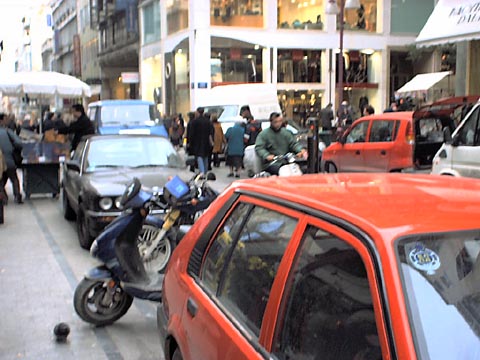
Ermou Street, in the "pedestrianized" area of central Athens ... depict a pedestrianized street? Yet this is a typical weekday condition on Ermou Street, the most central and commercial "pedestrianized" street in Athens. Do you think that this picture...
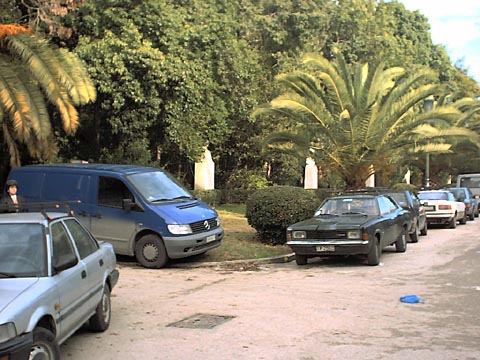
Pedion Areos, more a park for cars than people ... shows a park? It was taken at the Pedion Areos, one of just two "parks" in central Athens, during the Christmas holidays. If you were obliged to walk every day on "sidewalks" like this one...
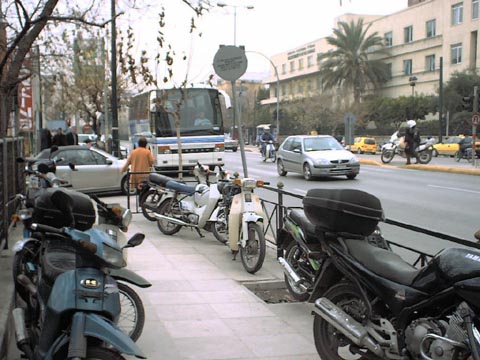
A typical Athens "sidewalk" on Alexandras Avenue ... how seriously would you take the administration's proud declarations? (And this isn't even the worst case - often, you would be forced to walk in the street.) Could you really believe the boasts of the municipality about the New Mobility Culture, carfree days, etc., if you regularly encountered pedestrian crosswalks like this one...
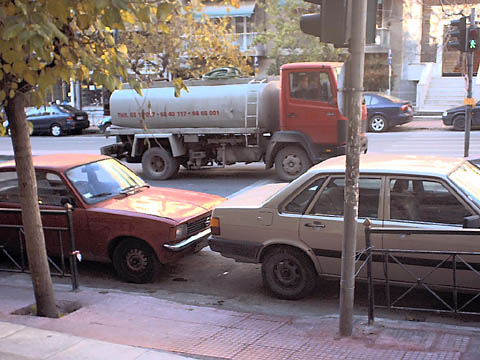
Example of "pedestrian crosswalk" at Panormou street: ... and you knew that the municipality, during the last three years, had adopted a program to erect fences like this one on the city's sidewalks, further worsening the already bad walking conditions caused by blocked pedestrian crossings and sidewalks? What conclusion would you draw regarding the determination of the authorities to protect and encourage pedestrians if the "sidewalk" in front of the traffic police headquarters looked like this...
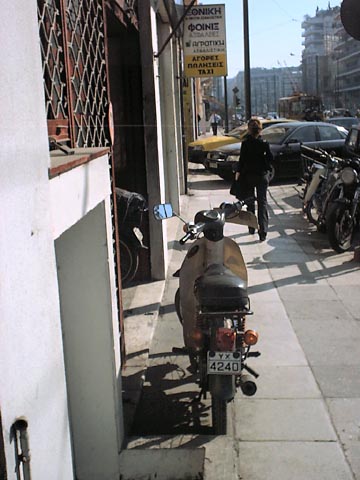
Deliyanni street: this is not exactly what the law dictates ... ? And what if you were told that a large program is underway to build garages in the center of the city (most of them destroying squares and open spaces), which obviously will attract still more motorized traffic to that part of the city center supposedly protected by the odd-even scheme? So just what is happening in Athens? For people far from Athens, such eagerness to join the sustainability agenda seems plausible and praiseworthy. However, most people living the reality of Athens don't take these big promises seriously, especially when they emanate from a state frequently accused of corruption and inefficiency and led by politicians who generally enjoy low esteem in Greek public opinion. Most people in Athens simply try to cope with the intolerable traffic conditions, but some still remember the route by which the situation deteriorated to its current condition. For many decades, the Greek state has followed a consistent policy of promoting private cars. The result was the decline of public transport's share in total mobility, from 65% in 1973 to 51% in 1983 and to 42% in 1996 (today it is estimated to have fallen further still) and a sharp increase in private car use. When, as the result of this policy, car ownership rose from about 200.000 some 30 years ago to almost 2 millions today, the narrow streets of Athens were saturated. For pedestrians, and especially the elderly, small children, parents with baby strollers, and the disabled, the situation has deteriorated sharply in recent years, in the service of slight improvements for motorized traffic. Instead of promoting public transit, walking, and bicycle use (which require serious programs and actual investments), the government perpetuated the pro-car policy (which earns profits for some and funnels tax revenues to the city treasury) and also promoted the motorcycle and motorbike in order to squeeze even more motorized traffic through the clogged streets. Motorcycles and motorbikes were granted an exemption from the odd-even scheme and from emission monitoring. They were taxed less than cars, and their use of the entire pedestrian infrastructure (sidewalks, parks, squares, pedestrianized streets, etc.) is illegally and unethically tolerated, disregarding pedestrians, despite the fact that the accident rate of two-wheeled motorized traffic is 15-30 times that of cars. The most vulnerable part of the population is denied their rightful safe use of pedestrian facilities. This irresponsible and inhumane policy remains in effect despite a recent study showing that two-wheeled motorized traffic causes more pollution than car traffic (although cars outnumber motorbikes and motorcycles). In fact, the freedom for motorcycle and scooter riders had recently been further extended - they are now permitted to use dedicated bus lanes, and the age limit for motorbikes (motorcycles with 50cc engines) has been lowered to 16. The concepts of sustainability and carfree development require serious commitment, not nice words and mockery. The brutal oppression of pedestrians and the deprivation of their constitutional and human rights to free and safe movement are not consistent with the needed improvements in quality of life and sustainability.
K. Tsourlakis is an engineer living in Athens. Thanos Vlastos responds: Mr. Tsourlakis accurately describes what is really happening today on Athenian roads. He also expresses his doubts regarding the will of politicians to assume the political cost of radical decisions - reducing car traffic and improving the urban environment. In my article, "Preparation for the 2004 Olympic Games in Athens: The city Pushes the Car Back from the Center," I focused not on the problems but on the positive policies being implemented within the framework of preparing for the Olympic Games. Unfortunately, environmental problems arise not only from the reluctance of politicians but also from the mentality of citizens, which takes time to change. The pedestrianization of the historic center is a good example for similar solutions that could be applied to other parts of the city. The social pressure for a better environment has resulted in many positive, ongoing projects such as the extension of the metro lines, the construction of a tram network, and the replacement of the bus fleet with buses running on natural gas. Restricting car use in Athens is not an easy issue, but the Olympic Games has offered a favorable opportunity to make progress. We have to be optimistic. What is important is that the mobility scheme planned for the Games is based on better pedestrian access and improved public transport, and that progress will continue beyond the conclusion of the Games.
|
Feature ArticleCarfree Zones in Mainland ItalyBy John BacherWhile Italy’s most famous carfree community is the Venetian island archipelago, less famous havens of sanity can be found on the country’s mainland. These sane islands in motor madness, have their roots in principled, activist social democratic municipal governments, which perpetuate the fierce civic pride of medieval Italian city states.A remarkable role in struggling for carfree zones has been played by Italy’s Democratic Party of the Left, formerly the Italian Communist Party. Its humanist policies, which in the past clashed with the dictates of Moscow’s dictatorship, now nurture vivid examples of carfree life. Its leadership has helped to establish them in the most unlikely of places, including the downtown shopping district of Naples, a city more famous for its driving hazards. With the gradual advance of auto-free zones in Florence and Rome, foreign motorists are advised to walk since, "many zones, such as that around Piazza di Spagna, are traffic-free and other traffic-free zones are being created." The Polarized Politics of AutomobilityNowhere else are politics as polarized around the car as in Italy. Rome’s first Communist Mayor, Carolo Giulio Argan, an art professor, attempted to ban cars from the Via de Fori Imperialli. Its traffic undermines the Coliseum. Such efforts by Rome’s ancient Senate ended with Argan’s defeat, and the Via is now a place to witness driving "like the chariot race in Ben-Hur."Cities with carfree zones in Italy are havens of the car restraint policies more commonly found in northern Europe. Most Italian cities have not recovered from the devastating impacts created by the widespread dismantling of trolley lines in the early 1960s. Milan was one of the few Italian cities to resist the anti-trolley fad and has Italy’s most extensive subway system. Its 70 km. metro is double the length of Rome’s. The jewel in the crown of its policies of car restraint is a pedestrian zone around its great gothic cathedral. Here wide streets are completely filled with pedestrians after work. On weekends larger parts of its historic core are carfree. Florence has a carfree zone composed of several streets near the market square of Piazza San Lorenzo. It is one of the few Italian cities to make a serious effort at restricting free parking. Florence and Trieste were the only Italian cities to take advantage of a 1979 program of the national government to fund park-and-ride facilities to boost transit. One of the most remarkable carfree areas of Italy, the rugged mountains of the Cinque Terre along the Italian Rivera, have retained their charm from antiautomotive activism. These five scenic towns of around 2,000 people, surrounded by terraced mountain vineyards. All are served by rail lines. Only one Monterosso, can be driven to by car over a reliable paved road. They are linked by the Seniteri Azzuri hiking trail, which have become a prized path for hikers and backpackers. Mountains alone did not protect the Cinque Terre from motorization. Road lobbies attempted to pave the communities together but were defeated through intense opposition. All these towns have strong regulations to restrict cars. When an attempt was made in the early 1960s to establish a taxi service in Monterosso, this was quashed by activists, who dug up a turn-of-the-century regulation. This forgotten by-law enabled the mayor to impose a speed limit of less than five miles an hour.
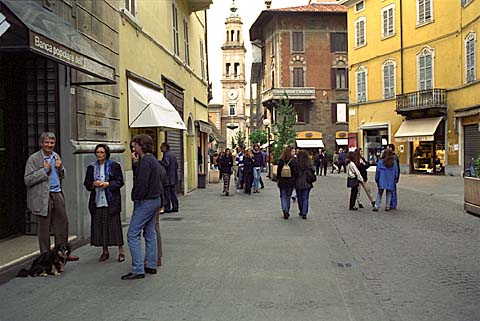 Evening promenade in Parma
Parma - Showcase of the Red BeltThe province of Emila-Romagna is a stronghold of the Democratic Party of the Left, the heart of northern Italy’s Red Belt. This is an unusual land of a prosperous and well-regulated capitalism, whose landscape is not marred by such grotesque features of auto culture as shopping malls. Its capital, Bologna, has been a world leader in car restraint since the election of its first communist government in 1964. The showcase, however, of the Red Belt is Parma, whose carfree district is a six block area in the city’s center. It bans cars from the Cathedral Square and its surroundings.American author Paul Hoffman visited Parma in the 1980s and met the Communist architects of its carfree zone. He found them to be highly cultured book lovers, who also collected paintings and old furniture Their greatest achievement is to have created a carfree community of 6,000 residents, in the ancient core which served as the background for the drama of Stendhal’s great work, The Charterhouse of Parma.
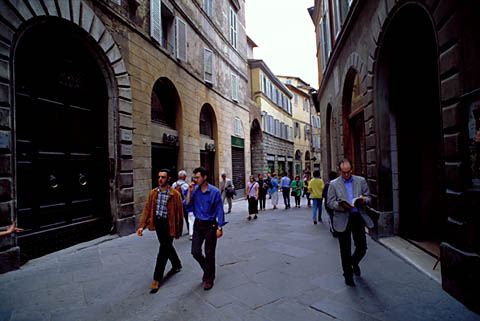 One of the main streets in Siena
Siena - A Mainland VeniceThe similarities between Siena and Venice were vividly captured by the mid-Victorian era novelist Charles Dickens, a crusading foe of the soot and grime of the early industrial age. He then viewed Siena as a "Venice without the water," a view now much more evident as the two communities have become havens for carfree living.Venice and Siena were well-planned cities long before the auto era. Although iron rings to tie up horses are still visible in Venice, they became relics centuries ago, when draft animals were banned from the republic. The one Venetian island where horseback riding is permitted is the seaside resort of Lido, where they are still carefully prohibited from the beaches. Both Siena and Venice have proud republican heritages from the Middle Ages. Siena especially epitomizes what American political scientist Robert Putnam has termed the importance of civic-mindedness. This he found sorely lacking in southern Italian cities once dominated by medieval tyrants and early 21st century mafias. Civic pride flourishes in the once free republican cantons of the north, which are the basis of the strength of the Democratic Party of the Left. Siena was a free city until conquered by Florence in 1554 following a siege that starved most of its citizens. Siena remains one of Italy’s strongholds of civic patriotism, with the black-and-white shield of the republican commune appearing on doors, windows, and building tops. The waving of Siena’s flag provides the basis for much of its civic festivities, which involve thousands of residents donning medieval costumes at the time of the Palio horse race through the city’s streets. A stronghold of the Democratic Party of the Left, Siena maintains a reputation as an intellectual city, with its university being a leading employer. It is a publishing center for the Franciscans and famed for the quality of its book stores. One of its prized artistic works are the frescos of Ambrogio Lorenzetti, on "The Effects of Good and Bad Government." The one featuring good government has a backdrop of young women dancing in the streets - much as they do today. To foster a strong civic spirit, Siena is divided into 17 parishes. These neighborhoods are planned as miniature cities, each with its own flag, church and patron saint, separate government building, archive, songs, flags, mottos, symbols, and museum. Each parish competes in the Palio horse race, which is dedicated to the Madonna. The streets of the winning parish become the scene of a great victory feast. Siena’s medieval fortress walls provide the boundaries of its virtual carfree zone. Like invading armies of the past, cars in Siena are kept outside the city walls. Inside its gates pedestrians may still occasionally have to avoid cars, but generally, as in the Middle Ages, there "are neither sidewalks nor cars in this city given over to the people." Its orange buses are powered by electricity, to keep Siena free of fumes. More Italian Carfree Communities ComingDuring the Cold War’s Italy’s maverick Communist prided themselves at rising above the simplistic messages of the extremes of right and left. This helped to give birth to the Eurocommunist movement that helped inspire Soviet democratic reformers to dissolve one of the world’s most oppressive empires. Today such humanistic thinking, reverential towards life and skeptical of the virtues of polluting machines, is expressed in increased momentum towards carfree zones. These are gradually ridding Italy of the ugliness one of its great philosophers, Antonio Gramsci, long derided as "Fordism".
John Bacher
John Bacher is the author of Petrotryanny, recently published by Dundurn Press and Science for Peace and reviewed in Carfree Times. #22 It contains considerable material on the extensive car restraint policies in Europe, Japan, and Singapore.
|
Book ReviewsThis is the fifth and probably last in a series of reviews of books on the construction of the transcontinental railroad. See issues 20 and 21 of Carfree Times for the first four reviews.
This book was written by an engineer, and it shows. The author was born just a month after the transcontinental railroad was completed, and, during his professional career, met some of the principals and corresponded with others. While there are distinct editorial lapses, the book delves quite deeply into the technical aspects of the construction of the transcontinental railroad, and even though it is comparatively short, it contains some information on the construction that is not to be found in, for instance, the exhaustive Bain book. Galloway begins with an interesting summary of the development of railroads from their origins in Britain in 1825 up to and even beyond the completion of the transcontinental railroad. One of the most interesting notes is how rapidly the weight of trains increased, and how this has continually necessitated the building of heavier track and stronger bridges (in fact, this trend continues even today). The second chapter describes preliminary surveys of the many routes considered. The remainder of the book is organized completely differently from the others so far reviewed: rather than being a chronology, the book divides into two principal halves, the first considering the Central Pacific, the second considering the Union Pacific. For each railroad, topics are taken up in the following order:
Galloway's writing has a peculiar tone to it, one that is perhaps characteristic of much writing in the late 19th century. There is a strong moralizing quality to it, and he refers frequently to the American Indians as "savages." The book also serves as something of a paean to the virtues of industry and the great deeds of engineers, a quality that becomes tedious. One minor annoyance: the edition reviewed and cited appears to be a facsimile reprint of an earlier edition, the date of which is not given. The work was almost certainly written between 1931 and 1943 (the year of Galloway's death), but nowhere is this information to be found. The book is properly bound but quite poorly printed, probably as a consequence of being a facsimile edition. The text contains quite a few typographic errors, and the illustrations are poorly reproduced. A first edition might be better in this latter respect. This book has obviously been used as a primary source by many later authors, and it appears quite authoritative. It includes a sound bibliography. I would especially recommend this book for those interested in the more technical aspects of 19th-century US railroad construction. Those seeking a more balanced work probably should start with the Williams book.
Reviewed by J.H. Crawford
|
Hot New LinksThe links below will open in a new browser window:Geometrical Fundamentalism by Michael W. Mehaffy & Nikos A. Salingaros, on the dogma of Modernist reductionism. This article integrates many disparate elements into a discussion of Modernism in architecture and urban planning, including the resentment by traditional cultures of globalism and its export of theocratic Modernism to their societies. World Oil Forecast #6 from Rich Duncan, dated 8 August 2001. Getting Over Oil by Charles C. Mann in MIT's Technology Review, January/February 2002. "Years of cheap oil have slowed energy innovation to a crawl. A new Middle East crisis could change that." A very rosy discussion of the future of fuel supplies. Energy Futures by John Benditt in MIT's Technology Review, January/February 2002. Myths of Light Rail - Debunked. Shedding Light on Alienation in the Public Realm: The case for more humane lighting of city streets. This is a more important matter than it might first seem. "An Interview with J.H. Crawford," Clamor Magazine, No. 10 (September/October 2001), (a Web Exclusive article, not included in the print version) by Pete Menchetti. About Carfree TimesNext IssueThe next issue of Carfree Times is scheduled for May 2002.Subscribe to Carfree TimesCarfree Times is published on Carfree.com in odd-numbered months. To receive e-mail notices of new issues, please visit the subscription page or send e-mail with the word "Subscribe" in the subject line. We do not share our mailing list. Write for Carfree TimesInterested in writing for Carfree Times? We welcome articles on a wide variety of subjects, and offer an opportunity to publish letters to the editor and guest editorials. Drop us an e-mail.Contact Information |
| Editor | J.H. Crawford |
| Tel. | +31 20 638 5115 (GMT +1) |
| Send e-mail | |
| URL | http://www.carfree.com/ |
Back to Carfree.com
Carfree Times Home
Continue on to Carfree Times Issue 23
About the book: Carfree Cities
carfree.com
Copyright ©2002 J.Crawford
